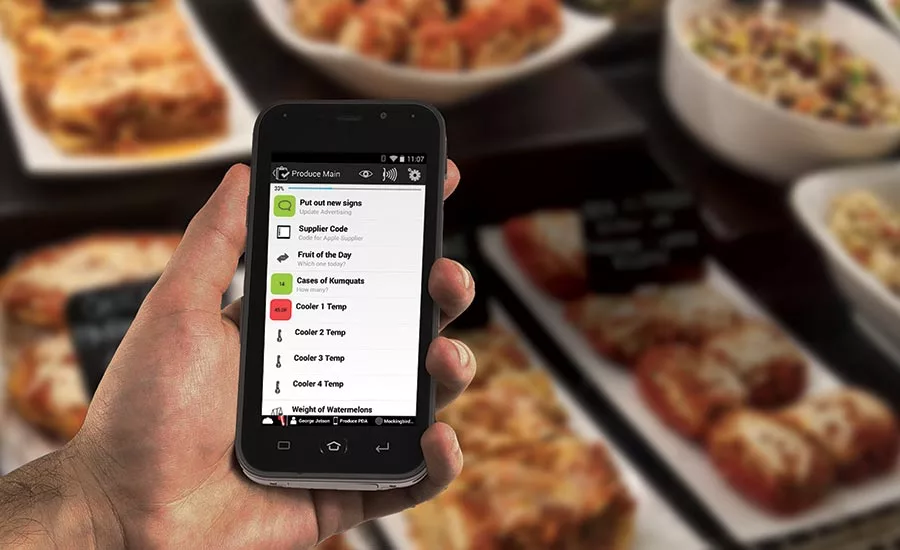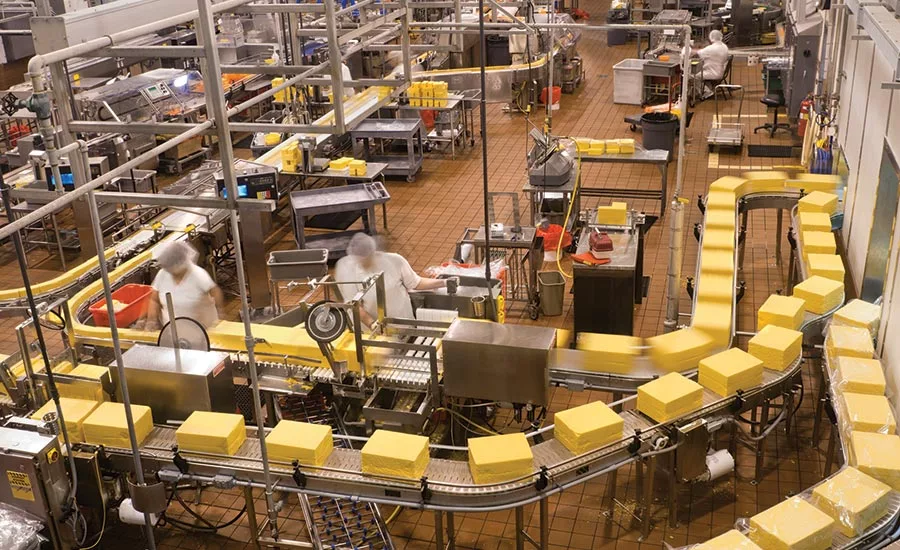The benefits of food safety management systems
Insights from processors and experts on why food safety management is especially essential in the food and beverage industry

Partech offers SureCheck, which combines software, a mobile tablet and built-in temperature measuring devices to help companies collect, track and store food safety data for anytime, anywhere access.
Photo courtesy of Partech

Food safety software reduces duplicate data entry and automates processes by centralizing data collection, tracking and analysis for environmental, health, safety and quality initiatives within a single application.
Photo courtesy of istock

Processors that use good food safety software can expect real-time metrics of what’s happening on the factory floor.
Photo courtesy of istock
What comprises a good food safety management system? In short, lots of recordkeeping and lots of paperwork.
Today, however, auditors, regulatory agents and even customers expect requested data to be produced fast, and to do that, more processors are using food safety software.
Article Index:
- Switching to software
- What’s involved in a good system?
- Sidebar: Food safety management system requirements
For example, Plex Systems says many food and beverage companies have recently launched its software in their factories and recall their live dates. For Shank’s Extracts, Inc., it was January 2012; for Sanders and Morley Candy Makers, Inc., it was June 2014; for Hausbeck Pickles and Peppers, it was March 2016; and for USHydrations, it was August 2016.
“Going live is like a birthday,” says Russ Edwards, ERP project coordinator at Hausbeck.
For many processors, using food safety software systems means finally getting rid of the rows of cabinets filled with Excel sheets and handwritten data. Some have been prompted to move recordkeeping and food safety management into the digital age by FSMA.
“FSMA is the biggest challenge that people are facing today,” says Gerry Gray, senior director, product strategy at Plex. “A lot of those companies are very shell-shocked.”
Gray says Plex, a subscription and cloud-based ERP system, can help processors navigate the regulations, which they can no longer risk taking lightly.
“It’s getting real. It’s not the FDA anymore; it’s the Department of Justice,” Gray explains. “There are people sitting in jail because of violations.”
Also helping food processors face the challenges of FSMA is Intelex Technologies Inc., which develops food safety and quality management software. Dan McLean, director of content strategy and communications at the company, says food safety always seems to be a moving target.
“The food safety regulatory landscape exists in a constant state of changes, and that challenges food and beverage companies to keep pace in tackling regulations that are seemingly in a constant state of evolution,” he explains.
For that reason, it’s important that food and beverage companies have food safety plans and software designed to evolve.
“Flexibility to accommodate future changes in regulatory compliance is essential,” McLean explains. “Relative simplicity and rapid deployment of system changes and upgrades are also key features.”
A good food safety software system should also support communication across sites and enable data to be collected and centralized from the quality and supplier management systems.
“This helps companies fill in the cracks of disparate and disconnected systems by mitigating risks and improving processes designed to achieve food safety,” McLean says. “Advanced analytics and computing capabilities that can be configured to address customers’ specific issues and complex regulation challenges are also critical capabilities.”
The company Partech offers SureCheck, which combines software, a mobile tablet and built-in temperature measuring devices to help companies collect, track and store food safety data for anytime, anywhere access.
Jordan Anderson, product marketing specialist at the company, says its system incorporates infrared temperature measurement, which is great for checking surfaces, freezers, products within freezers, etc. with RFID capability. And the RFID capabilities can be used to log temperature measurements at specific locations.
“It is useful when verifying checks along employee travel paths,” he explains. “One of the benefits of utilizing an RFID tag is that it requires the employee to go to the location of the tag and obtain temperature data from the tag. In this case, the employee may also be required to check the condition of the freezer or cooler while there.”
Switching to software
For processors hesitant to make the switch to using software for managing food safety, McLean says it’s worth it.
“It can often be more difficult and complex to manage [the] food safety regulatory and compliance process using archaic spreadsheets and paper-based processes,” he explains. “Software and software-as-a-service solutions are integrated and typically feature easy-to-use and mobile features. Software-based food safety management systems let all business departments and multiple sites access shared and up-to-date records, plus provide the ability to manage requirements and other critical food safety metrics through a single centralized repository.”
Anderson says switching is not as complicated as some companies may think.
“By simply adopting food safety best practices, coupled with the utilization of [an] all-in-one food safety device, the training and data captured by these technologies is relatively seamless and accurate,” he explains.
Plus, food safety software tools can be used to both manage food quality and maintain supply chain traceability.
Gray says larger organizations aren’t seeing new software as the barrier they once did. And when it comes to Plex, the cloud-based systems make upgrades seamless. Smaller companies also have become very receptive to using software.
“They can’t grow their business with the manual systems they had in place,” Gray explains.
However, experts agree that executives and management must support and provide the resources required to build and maintain the food safety management system put in place. McLean says the importance placed on food safety must run through the entire organization.
“It isn’t just the responsibility of those whose specific jobs may be to manage compliance and regulatory processes,” he says. “Experts in the industry agree—quality and safety must be the responsibility of all. Everyone should be involved. Effective communications, education and demanding accountability for the right behaviors and actions of every stakeholder is the foundation of a culture focused on food safety and quality. It needs to come from the C-level of management—flowing down from the top and throughout the entire organization, including the supply chain.”
Sometimes, making a food safety management change can be quite easy. Before executives at pickle producer Hausbeck decided to use Plex software, staff was using QuickBooks and paper spreadsheets, so a change was welcome.
“What was going on [on] the plant floor was so tedious that the people didn’t resist,” Edwards says. “It was such a mess.”
What’s involved in a good system?
Vinca, LLC helps companies become certified in ISO 22000. ISO 22000 defines a food safety management system as listing interactive communication, system management, prerequisite programs and HACCP principles as key. Thus, Vinca’s guidelines for a good food safety management system include:
- Effective Prerequisite Programs in place to ensure a clean, sanitary environment
- A Hazard Analysis and Critical Control Plan developed to identify, prevent and eliminate food safety hazards
- Established documented food safety management system processes to manage food safety throughout an organization—from management and business planning aspects to day-to-day communication and operations affecting food safety.
And, as Vinca explains, companies are required to “identify what records are required for your food safety management system. Consider regulatory requirements as you make your list. You will need to determine how long records must be maintained and establish a system of accumulating and storing your records, so that they are always legible, retrievable and protected.”
So, how does a good food safety management software system specifically help processors with these tasks?
First, McLean says, software centralizes data collection, which gathers all FSMA compliance information and activities to reduce duplicate data entry. Also, software enables the tracking and analysis of environmental, health, safety and quality initiatives within a single application.
It can also provide real-time metrics, dashboards and reports for live assessments of the conformance status to standards, including ISO 9001, ISO 14001, OHSA and other frameworks.
“Software systems store and manage all FSMA-related compliance data in a secure, accessible web-based system. These systems allow organizations to gain complete and real-time visibility into the ongoing status of FSMA compliance,” he explains.
They also simplify food safety management overall, allowing companies to manage food safety in a system designed to streamline the processes for FSMA requirements.
“It [the system] lets you perform hazard analysis, implement risk-based preventive controls, monitor their effectiveness and implement corrective actions where necessary,” McLean says.
And it encourages the development and sharing of best practices across departments. The best functions and features of departmental processes shared within integrated software solutions create efficiency and encourage collaboration, which drives innovative ways to increase productivity.
They also ease management of supplier-related compliance.
“Software systems provide the means to manage supplier approval and verification activities and ensure these are conducted in accordance with the FDA’s requirements, including regulations for Foreign Supplier Verification Programs [FSVPs],” McLean explains. “Software systems provide the means to more easily and efficiently maintain a record of certifications, product tests, nonconformances, corrective actions and more.”
And, of course, a good food safety management system will ensure comprehensive FSMA compliance.
“Software systems provide the ability to schedule and track activities associated with compliance requirements, from internal inspections to identified corrective actions resulting from a nonconformance,” McLean says. “Automated notifications and reminders ensure accountability and task completion.”
Maybe most notably, good software systems also will allow processors to demonstrate compliance to auditors.
“Software systems create a clean audit trail, ensuring that regulated data and activities are well-documented and always at your fingertips to show inspectors or auditors as proof of your due diligence and compliance,” McLean explains.
Software can help processors prepare for audits by making it easier to meet audit management, nonconformance and product defect tracking management requirements. For example, after Shank’s Extracts started using Plex, the company reduced its prep time for quality certifications and audit compliance from two to three weeks to mere hours.
Sallie Rhineer, director of operations at Shank’s Extracts, says before the company had food safety software, tracking was hit and miss. In fact, the company would get audited and literally have to bring out carts of paper. Now, everything is labeled and scanned and has a barcode.
“The accuracy went through the roof,” she says, and adds a word of encouragement to other processors considering the switch to software. “Just do it. You’re definitely going to get your money’s worth.”
Food safety management system requirements >>
For more information:
Intelex Technologies Inc., www.intelex.com
Plex, www.plex.com
Partech, www.partech.com
Vinca, LLC, www.22000-tools.com
Looking for a reprint of this article?
From high-res PDFs to custom plaques, order your copy today!







